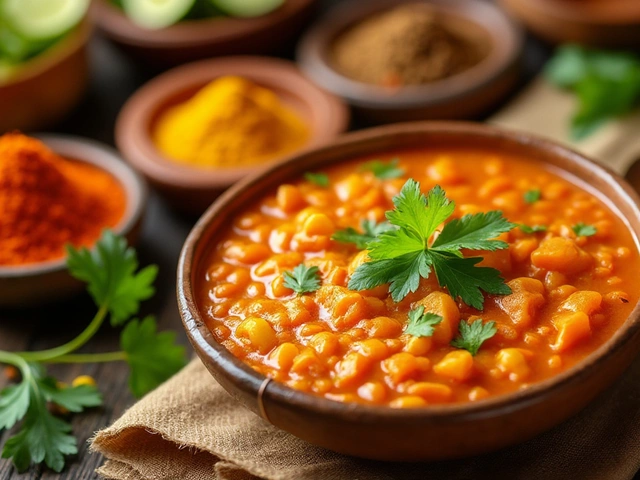Ever taken a sip of strong coffee or bitten into a grapefruit and pulled a face? Bitter flavors always stand out. Sometimes they add depth, like with dark chocolate, coffee, or certain greens. At other times, bitterness hijacks your meal or drink, turning a delicious dish into a struggle. But here’s the twist most people ignore: bitterness isn’t always the villain. It’s a signal from your tongue, often warning you about potential toxins — a smart evolutionary trick. Still, when a meal goes wrong or you’re desperate to save that sauce, you need a fix, and fast. Let's bust myths and get straight to what actually works for cancelling bitter taste in the kitchen.
Why Do Foods Taste Bitter? The Science and Psychology of Bitterness
The first question that jumps out is why some foods taste more bitter in the first place. It all ties back to our genetics. Humans have at least 25 different types of bitter taste receptors, far more than for sweet or salty tastes. Scientists believe this happened because our ancestors needed to spot (and spit out!) poisonous plants. Imagine being a gatherer thousands of years ago—bitterness literally kept you alive. But certain cultures, and even individuals, are more sensitive to bitterness. For example, about 25% of people are so-called "super-tasters." That means broccoli, kale, and brussels sprouts might taste brutal to them, while others barely notice the bite.
Over time, we learned ways to embrace, cover up, or cancel bitterness. That’s why Indian bitter gourd curries are paired with sweet and spicy chutneys, and why a dash of milk is almost always added to strong tea. Bitterness can show up in burnt spices, over-brewed coffee, overcooked greens, or the white pith in citrus fruits. The moment bitter dominates your dish, your taste buds go on high alert. There’s a difference between bitterness (like in cocoa or coffee) and actual food gone bad, but when you’ve just over-roasted your veggies or left coffee on the stove too long, you want a fix you can trust.
Sometimes bitterness comes down to food processing. For instance, phenolic compounds and alkaloids are common plant-based chemicals that mess with your taste buds. Cooking methods influence them—grilling, stewing, blanching, or even adding salt can change how bitter a vegetable tastes. And then there are hidden culprits, like the overuse of certain spices, charred garlic or onions, or even a bad batch of olive oil. If you’re in the kitchen and hit that bitterness wall, remember: the right science-backed kitchen hack can turn things around.

The Best Ways to Reduce or Cancel Bitter Taste
You don’t have to pitch your pan or dump that smoothie. The kitchen hacks to cancel unwanted bitterness are simple, fast, and won’t mess with your recipe’s heart. Here’s how cooks—home and pro—tame bitterness and get dishes back on track.
- Add Sweetness: This is the classic move. A sprinkle of sugar, a drizzle of honey, or a cube of jaggery can balance out many bitter ingredients. French cooks even add a sugar cube to tomato sauces if they taste sharp.
- Bring in Acid: Lemon juice or vinegar works almost like magic. Acidity distracts your tongue and rewires your perception of strong, bitter flavors, especially in greens or sauces.
- Salt to the Rescue: Salt doesn’t just mask bitterness—it suppresses it directly on your taste buds. Just a pinch (not a handful!) can dial things back dramatically. That’s why salted chocolate tastes smoother than unsalted dark variants.
- Add Fat or Dairy: Cream, coconut milk, butter, or yogurt can round out rough edges. The fat coats your mouth, muting those harsh bitter notes, which is why tossing bitter greens like kale in oil before baking or sautéing is so popular.
- Mix in Herbs and Spices: Spices like cinnamon, cardamom, or coriander soften bitterness. Vietnamese cooks often pair bitter melon soup with ginger and plenty of pepper for the same reason.
- Use Umami Boosters: Soy sauce, miso, cheese, or mushrooms can cover up and balance bitterness, creating a more complex, satisfying flavor. The glutamates in these foods work on a different set of taste buds and distract from what you don’t want.
Sometimes, it’s all about technique. Blanching bitter veggies for just a minute, then plunging them into ice water, can leach out a lot of the bitterness without overcooking them. If you’re making coffee or tea, brewing too long pulls out excess bitter compounds, so set a timer and pour promptly. And here’s a wild fact: Even the temperature you serve your food at can make a difference. Cold tends to mute bitterness, which is why grapefruit in a salad tastes milder than straight from the room-temperature fruit bowl.
For more specific advice, here’s a little table with quick “save-my-dish” tips for common situations:
| Food or Drink | Typical Bitter Culprit | Quick Fix |
|---|---|---|
| Over-brewed coffee | Excess extraction | Add a dash of milk or cream, or a pinch of salt |
| Roasted vegetables | Charring, glucosinolates | Toss with olive oil, citrus juice, or a drizzle of honey |
| Kale salads | Bitter phytochemicals | Massage with salt and lemon, add fruits or nuts |
| Bitten citrus peel | Pith (white part) | Pare peels thinly, or add a sweetener when using zest |
| Dark chocolate desserts | High cocoa solids | Pair with sea salt or candied nuts |
One last sly tip: bitterness sometimes fades just with repetition. Regular kale eaters barely blink at its bite after a few weeks. The brain adapts, especially when you keep things interesting with new pairings and preparations. But if you need an instant rescue, sweet, sour, salty, and fatty additions are your best friends.

Everyday Recipes and Real-Life Uses: Winning Over Bitter Flavors
The best part about cancelling bitterness is that it’s usually about working with what you’ve already got. Turn those failed dishes around, and you’ll feel like a kitchen magician. Let’s look at some real-life Indian and international examples that use these tricks and taste so much better because of it.
Take the humble bitter gourd (karela), which is a staple in many Indian homes. Most people slice, sprinkle with salt, and leave it for about thirty minutes. This process “sweats” out the bitter juices. A quick rinse, and then bitter gourd is fried with onions and a touch of jaggery or tamarind. Suddenly, all those tough flavors mellow out. The same logic works with aubergine—salting the slices before frying keeps the taste balanced. In Europe, anchovy-based sauces often add salty-umami depth to bitter green salads, transforming them instantly.
Let’s talk leafy greens. Spinach, kale, and rocket often split families—some love the punchy taste, others grimace at the bitterness. The trick? Blanch leaves for fifteen to thirty seconds, then shock them in ice water. Squeeze out excess moisture, and use with bright additions like sliced apples, roasted nuts, or a tangy vinaigrette. Even fancy chefs swear by this simple kitchen science when prepping bitter greens. If you like your coriander chutney but find the raw taste harsh, blending in a pinch of sugar or a squeeze of fresh lime does the job perfectly.
The same approach works for drinks. Grapefruit cocktails or tonics can be too sharp, so bartenders add a syrup or muddle sweet fruit to mellow things out. The trick is not to erase bitterness completely—it’s to balance it, so it sings with the other flavors instead of shouting over them.
For a sweet treat, dark chocolate is often paired with salt or something creamy. One scoop of vanilla ice cream with a piece of 85% cocoa chocolate becomes a match made in heaven because the fat and sugar instantly buffer the bitter hit. You can apply the same rule to homemade brownies: a bit of salt and good-quality butter will smooth out even the darkest batch.
Even stubborn coffee can be fixed. If your morning brew is too strong, skip extra sugar and add a pinch of salt. Studies from the University of Oxford proved that salt counteracts bitterness and even enhances other flavors, so your coffee tastes richer, not just less bitter. If you’re working with espresso, serve it alongside a biscotti or a sweet date—after one bite, the bitterness barely registers.
If you want to get creative, look at the world’s cuisines for inspiration. Italian cooks love to serve bitter radicchio grilled and then drizzled with honey or balsamic. Moroccans use preserved lemons, which mellow out bitterness in tagines. In South Africa, wild greens like morogo get simmered with onions and a splash of vinegar. Tiny tweaks, huge payoff.
If you ever feel like your cooking is stuck in a rut because of bitterness, remember it’s just your taste buds raising an alarm. Grab for an acid, a sweetener, or a splash of fat, and you’ll set things right without much fuss. The next time you get hit by that sharp, bitter note in your dinner, you’ll know exactly what to do. Trust your taste and don’t be afraid to experiment—you’ll learn fast what works for you in your own kitchen.
- Poplular Tags
- bitter taste
- cancel bitter taste
- kitchen tips
- food science
- flavor tricks











